Language:Japanese
When you think of Fushimi Inari Taisha, you probably think of the “Thousand Torii Gates” and the “Koma Foxes.” However, there are many places around Mount Inari that are not well known.
This time, I will introduce the route towards Ichinomine via Takenoshita-michi and what we saw along the way.
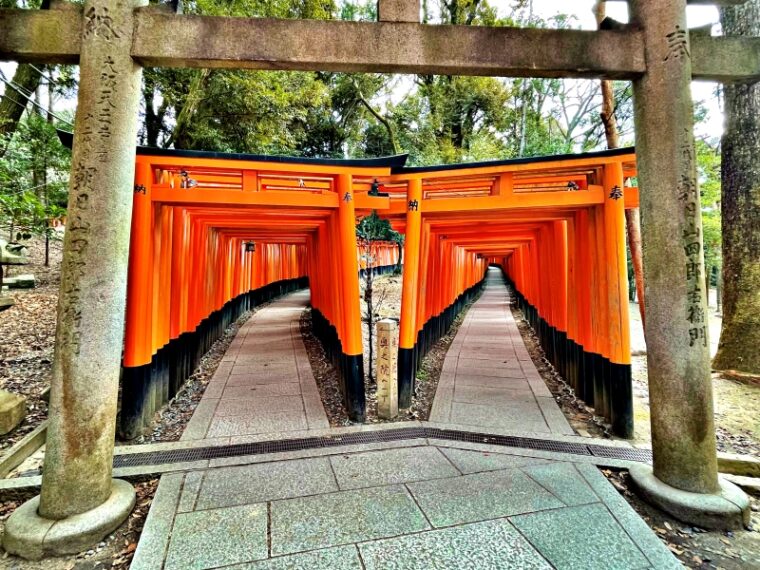
Once you pass through this Thousand Torii Gates, you will find the Okusha-Hohaisho, which is popular for its Omokaru-Ishi. If you head a little north from here and climb the mountain path on the east side, you will come to Fushimi Kandakara Shrine.
The deities worshipped at Fushimi Kandakara Shrine are Amaterasu Omikami and Inari Okami, and the shrine enshrines the Ten Sacred Treasures.
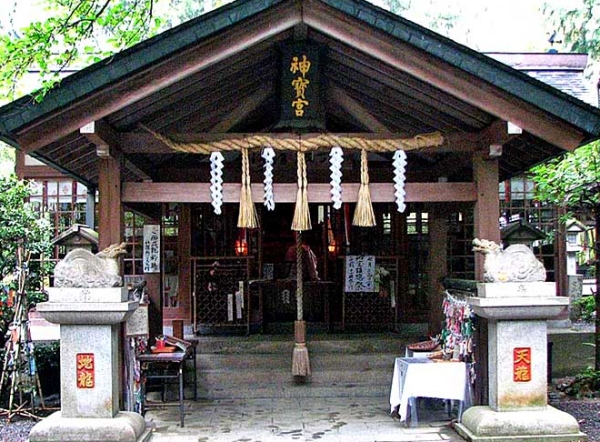
More details about Fushimi Kandakara Shrine can be found on the following page.
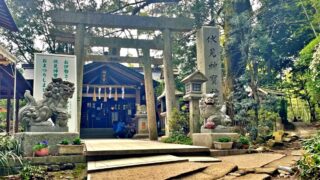
This area is said to be associated with “The Tale of the Bamboo Cutter,” and there are many bamboo groves nearby.
Today, this is the starting point.
Bungaku-Sanpo (Literary Walk) Takenoshita-michi
To the left of the entrance to Fushimi Kandakara Shrine there is a sign that reads “Bungaku-Sanpo (Literary Walk) : Takenoshita-michi.”
During the Heian period, Fukakusa was a place of longing for the people of Omiya, where villas and manors were built and elegant banquets were held throughout the seasons for flower viewing, hunting, moon viewing, etc. The atmosphere of the time is recorded in documents and literary works such as The Tale of Genji. The Takenoshitamichi was the road from the foot of Mt. Inari to the direction of Ookamedani, crossing Kowata and leading to Yamato.
Quote: (Bulletin board) Literary Walk | Takenoshita-michi
The bulletin board with this writing, which also has short poems on it, brings to mind a playground for aristocrats during the Heian period.
Since I had no intention of going to Ookamedani, I decided to walk along the Takenoshita-michi towards the peak of Mt. Inari that I could see in front of me.
Takenoshita-michi

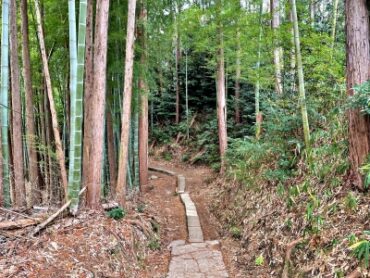
Would this path really take me to Ichinomine? I kept walking along the mountain path surrounded by bamboo thickets, feeling uneasy, but the only things I occasionally saw were warning signs such as “Beware of wild monkeys!” and “Wild boar…!”, there is no sign of people at all.
Maybe it’s better to turn back? As I was walking, I was a little relieved when I found a guide board with a large map of the Fukakusa Trail.
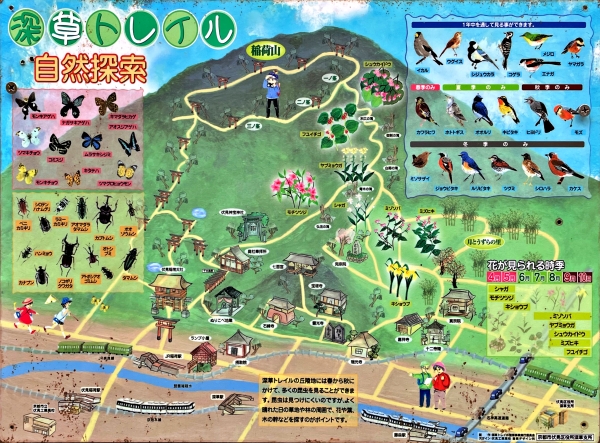
It might be a good idea to explore nature such as wild birds, butterflies, and insects during the nice season to see if this kind of nature still exists in Kyoto City! I felt a little happy.
Kobo-ga-taki (Waterfall)
As I pass through the bamboo thickets, I can see farm-like houses in the distance here and there, giving you the feeling that there are finally people around. Then I found a diagonally slanted sign that read “Kobo-ga-taki.”
I thought that if there was a waterfall in the name, there must be a waterfall somewhere, and when I passed through the torii gate, I saw that the dignified-looking Fudo Myoo was enshrined there.
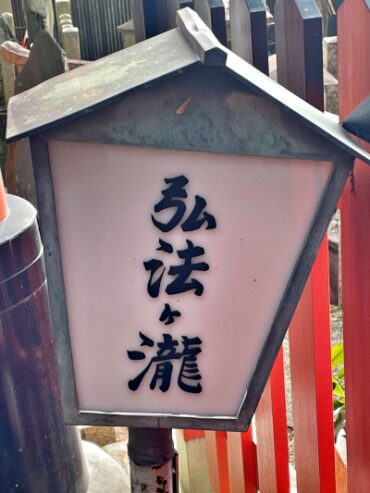
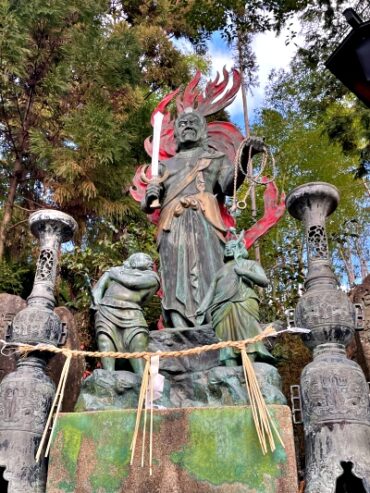
I could hear the sound of water coming from somewhere, so I followed it and found a small waterfall with a sign saying “Please do not enter the pilgrimage site.”
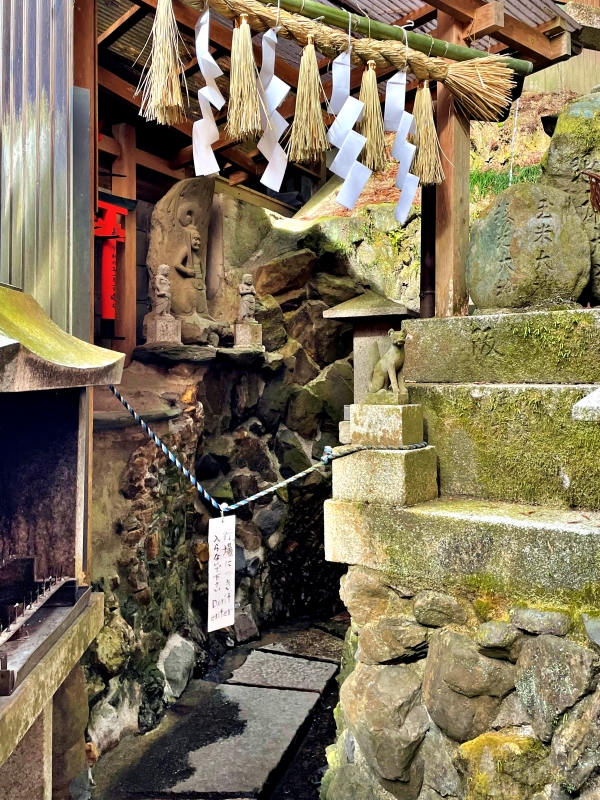
Near the waterfall, a woman who looks like an old woman was praying in front of a stone statue, perhaps preparing for a ritual. Perhaps she is silently concentrating throughout, and I feel a strong sense of energy that belies she’s appearances.
Feeling eerie, I fled the scene and headed towards Mt. Inari, but what I heard behind me was probably the woman from earlier chanting “Heart Sutra.”

I’m not sure if I can call it a shrine grounds, but this place, where various large and small stone statues and torii gates are enshrined, feels like it has a mysterious “energy” hanging over it.
Aoki-ga-taki (Waterfall)
After walking for a while, I will see a stone sign with the words “Aoki-ga-taki” carved into it, and right next to it is a
To reach the heart of the invisible God
The truth of a person’s heartPurify yourself with water from the waterfall and pray
Divine wish fulfillment
It is written.
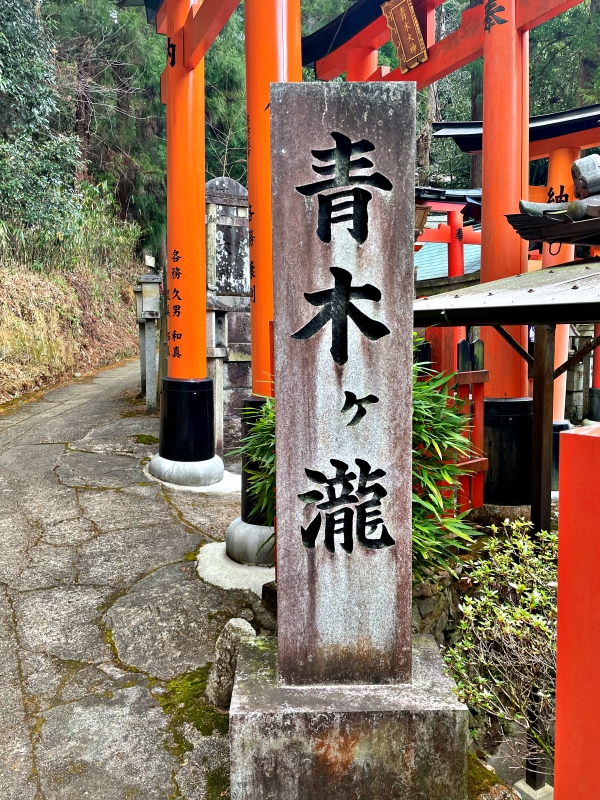
Also, there seems to be a waterfall for training here as well, but if there is no shrine office, there be no people. I thought about going inside to see where the waterfall was, but I was so overwhelmed by the silence and the sight of the shrine and torii gate that was dedicated to the deity that I decided to run away from here as well and move on.
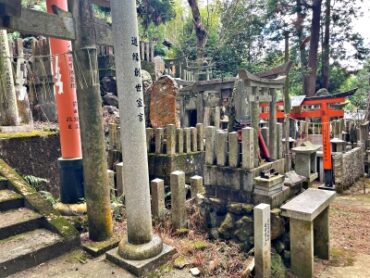
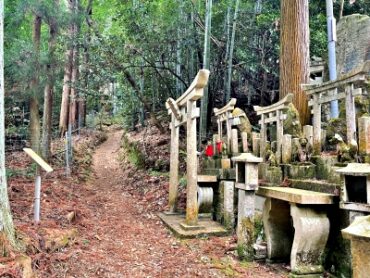
Fallen wild cherry tree
While I was walking, wondering where Mount Inari was, I came across a fallen mountain cherry tree.

This wild cherry tree apparently fell in April 2010, but efforts are being made to revive it under the guidance of experts. New branches are growing from the tree, which has been reinforced with bamboo and wood, and it looks set to bloom this spring.
150 meters to Ichinomine
How much time has passed since I walked down the only road I had no choice but to go forward? I was finally able to reach a paved three-way intersection where cars could pass. There was a sign that read “(Ichi-no-mine) 150m”, but I wondered where Mt. Inari was. It shouldn’t be strange to be able to see it from 150 meters away.
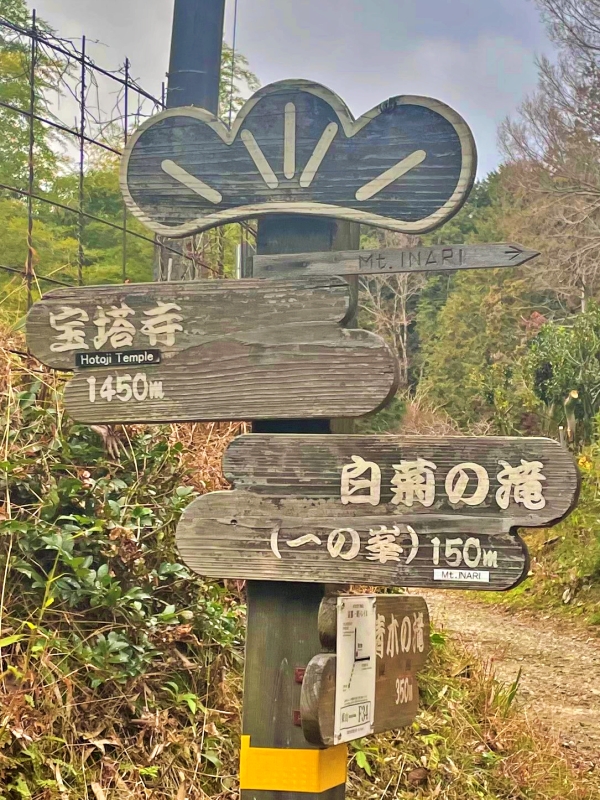
Shiragiku-no-taki and Falls and Mitsurugi-no-taki (Waterfall)
As I walked along the signposts, I saw another series of waterfalls, “Shiragiku Falls” and beyond that “Mitsurugi Falls.” Beyond that, I can see what looks like Mount Inari, but it feels much further away than 150 meters.
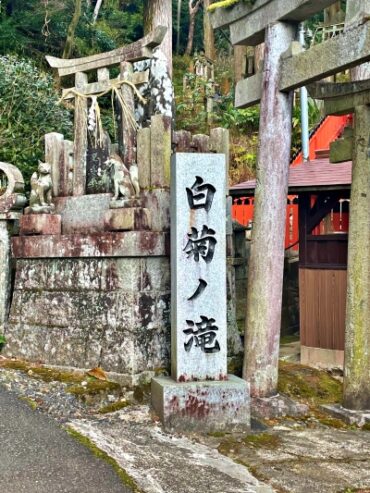
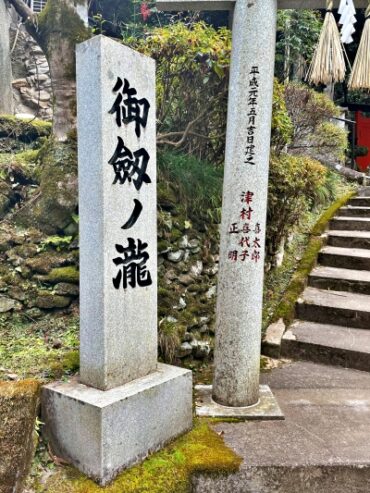
I’m not sure if it was because I was getting tired that the 150m felt so long, or if the signs were wrong, but I finally found the path leading to Mt Inari.
Hell’s climbing route
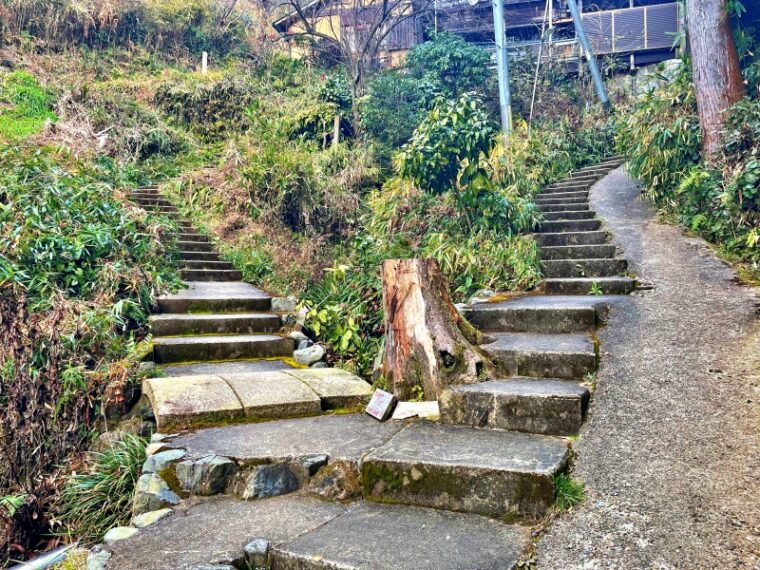
The path on the left leads to “Mt. Inari Summit” and the path on the right leads to “Oiwa Okami.” The sign says, “15 minutes’ walk to the summit,” and when I look up I can see Mt. Inari right there. I thought, “I’ve finally arrived!” But if it looks so close, does that mean I have to climb a steep hill? …I have a bad feeling about this.
Heart-Breaking Mountain Path
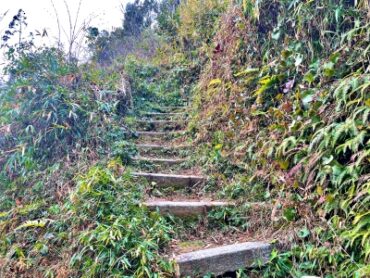
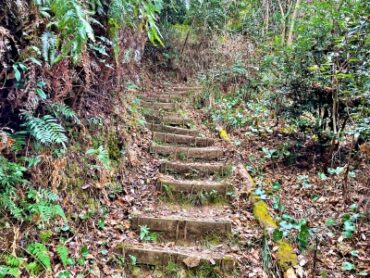
Step by step, you climb up the steep stairs made of square stone sticks. With this slope, it seems that it is correct to “reach the summit in 15 minutes”, but that is only if I keep walking without stopping, and I think it is impossible unless you are very physically fit.
At the corners of the winding mountain path, there are handrail-like platforms for resting.
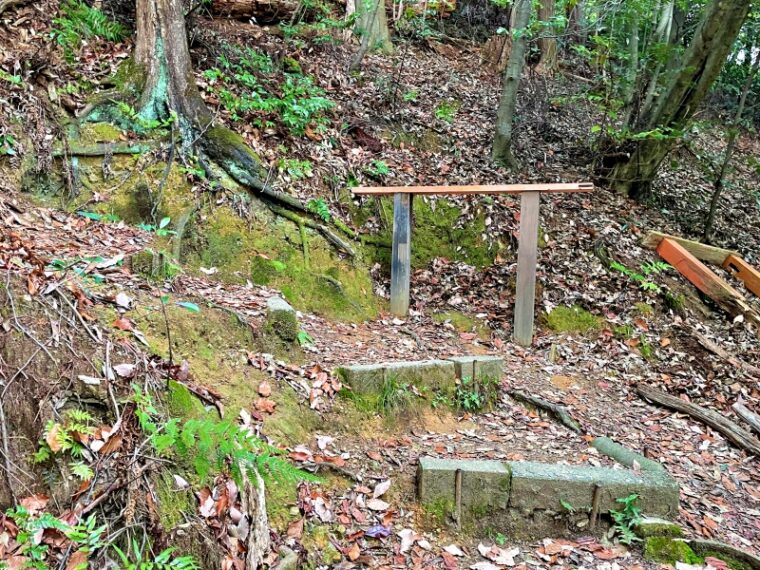
My breath was rising, my legs were shaking, and after taking four breaks, I finally saw the torii gate and thought, “I’ve arrived!” For the time being, I just sit there and take a break. Even though it was mid-winter, I couldn’t stop sweating, and if I continued to rest like this, I would get cold, so I quickly started walking towards “Ichinomine”.
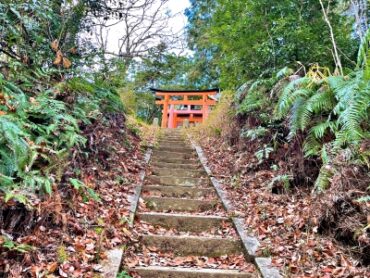
The torii gate finally comes into view
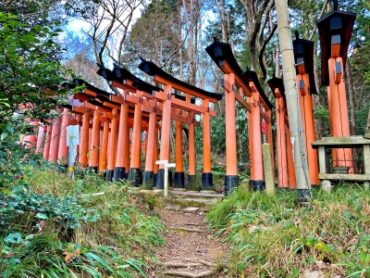
Torii on the worship path
If I go to the left, “Ichinomine”‘ is almost there! Once I get this far, it’s a piece of cake! The pilgrimage path that I usually find difficult now feels very easy.
We finally arrived at Ichinomine.

I left Fushimi Kndakara Shrine at 11:15 and arrived at Ichinomine at 12:00, so it took about 45 minutes. It didn’t seem like it took that long, but considering the steepness of the road, it felt like we walked for about half a day.
In conclusions
There seem to be many mysterious shrines and training grounds around Fushimi Inari Taisha that I have yet to discover. I didn’t see anyone at the shrine I came across today as I was passing by, except for an old woman who was practicing ascetic practices, but I feel like the grounds were well-maintained. There were also signs that someone had visited the shrine, so it seems that there are quite a few people who come to worship there.
Next time I explore it, I’ll let you know!
Reference link : Kyoto City Fukakusa Trail

